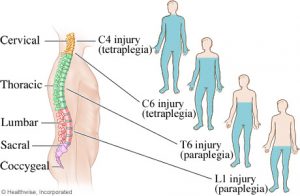Introduction
A spinal cord injury (SCI) refers to damage or trauma to the spinal cord, resulting in a loss of function and sensation below the level of injury. It can occur due to accidents, falls, sports injuries, or medical conditions. SCI can have a significant impact on a person’s mobility, sensation, and overall quality of life.

Symptoms
The symptoms of a spinal cord injury can vary depending on the severity and location of the injury. Common symptoms may include:
Paralysis: Loss of movement and sensation below the level of injury. The extent of paralysis depends on the level and severity of the injury.
Loss of Sensation: Reduced or absent sensation below the level of injury, including the ability to feel touch, pain, or temperature.
Loss of Bladder and Bowel Control: Difficulty controlling urination and bowel movements.
Spasticity: Involuntary muscle spasms or stiffness.
Respiratory Problems: Depending on the level of injury, breathing difficulties may occur, requiring assistance or respiratory support.
Diagnosis
Diagnosing a spinal cord injury typically involves a comprehensive assessment by medical professionals, including neurologists or spinal cord injury specialists. Diagnostic procedures may include imaging tests such as X-rays, CT scans, or MRI scans to identify the location and severity of the injury. A thorough neurological examination is conducted to assess motor and sensory function, reflexes, and the extent of paralysis.
Treatment
Treatment for a spinal cord injury focuses on stabilizing the spine, preventing further damage, and maximizing functional recovery. Treatment options may include:
Immobilization: Immobilizing the spine using braces, collars, or traction devices to prevent additional movement and stabilize the injured area.
Surgery: In some cases, surgical intervention may be required to relieve pressure on the spinal cord, stabilize the spine, or repair damaged structures.
Medications
Medications may be prescribed to manage pain, muscle spasticity, and other complications associated with spinal cord injury.
Rehabilitation
Extensive rehabilitation is crucial for individuals with spinal cord injuries to optimize recovery and regain functional abilities. Rehabilitation programs may include physical therapy, occupational therapy, and speech therapy. These therapies aim to improve strength, mobility, independence in daily activities, and communication skills.
Lifestyle Changes
Living with a spinal cord injury often requires significant lifestyle adjustments:
Mobility Aids: Depending on the level of injury and functional abilities, individuals may require assistive devices such as wheelchairs, crutches, or walkers to enhance mobility and independence.
Home Modifications: Adapting the home environment to accommodate accessibility needs, such as ramps, grab bars, and widened doorways, can improve mobility and safety.
Bladder and Bowel Management: Developing a routine for managing bladder and bowel function through techniques such as intermittent catheterization or bowel programs can help maintain optimal health and hygiene.
Pressure Ulcer Prevention: Individuals with spinal cord injuries are at a higher risk of developing pressure ulcers due to prolonged sitting or lying down. Regular skin checks, frequent position changes, and specialized cushions or mattresses can help prevent pressure sores.
Emotional Support: Coping with the emotional and psychological impact of a spinal cord injury is crucial. Seeking support from loved ones, joining support groups, or engaging in counseling can provide valuable emotional support and strategies for adjustment.
Adaptive Technology: Exploring and utilizing assistive technologies, such as voice-activated devices or adaptive tools, can enhance independence and participation in daily activities.
Living with a spinal cord injury presents unique challenges, but with proper medical care, rehabilitation, support, and adaptive strategies, individuals can lead fulfilling lives and achieve a sense of independence and well-being. It is important to establish a strong support network, set realistic goals, and work closely with healthcare professionals to optimize recovery and adapt to the changes brought about by the injury.







